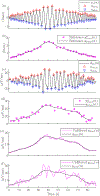Tracking Tidal Volume From Holter and Wearable Armband Electrocardiogram Monitoring
- PMID: 38557616
- PMCID: PMC11866305
- DOI: 10.1109/JBHI.2024.3383232
Tracking Tidal Volume From Holter and Wearable Armband Electrocardiogram Monitoring
Abstract
A novel method for tracking the tidal volume (TV) from electrocardiogram (ECG) is presented. The method is based on the amplitude of ECG-derived respiration (EDR) signals. Three different morphology-based EDR signals and three different amplitude estimation methods have been studied, leading to a total of 9 amplitude-EDR (AEDR) signals per ECG channel. The potential of these AEDR signals to track the changes in TV was analyzed. These methods do not need a calibration process. In addition, a personalized-calibration approach for TV estimation is proposed, based on a linear model that uses all AEDR signals from a device. All methods have been validated with two different ECG devices: a commercial Holter monitor, and a custom-made wearable armband. The lowest errors for the personalized-calibration methods, compared to a reference TV, were -3.48% [-17.41% / 12.93%] (median [first quartile / third quartile]) for the Holter monitor, and 0.28% [-10.90% / 17.15%] for the armband. On the other hand, medians of correlations to the reference TV were higher than 0.8 for uncalibrated methods, while they were higher than 0.9 for personal-calibrated methods. These results suggest that TV changes can be tracked from ECG using either a conventional (Holter) setup, or our custom-made wearable armband. These results also suggest that the methods are not as reliable in applications that induce small changes in TV, but they can be potentially useful for detecting large changes in TV, such as sleep apnea/hypopnea and/or exacerbations of a chronic respiratory disease.
Figures



Similar articles
-
Electrocardiogram Derived Respiration for Tracking Changes in Tidal Volume from a Wearable Armband.Annu Int Conf IEEE Eng Med Biol Soc. 2020 Jul;2020:596-599. doi: 10.1109/EMBC44109.2020.9175486. Annu Int Conf IEEE Eng Med Biol Soc. 2020. PMID: 33018059
-
Comparison Between a Single-Lead ECG Garment Device and a Holter Monitor: A Signal Quality Assessment.J Med Syst. 2024 May 27;48(1):57. doi: 10.1007/s10916-024-02077-9. J Med Syst. 2024. PMID: 38801649 Free PMC article.
-
Feasibility of Long-Term Daily Life Electrocardiogram Monitoring Based on a Wearable Armband Device.Annu Int Conf IEEE Eng Med Biol Soc. 2019 Jul;2019:4314-4317. doi: 10.1109/EMBC.2019.8857219. Annu Int Conf IEEE Eng Med Biol Soc. 2019. PMID: 31946822
-
Wearable Electrocardiogram Technology: Help or Hindrance to the Modern Doctor?JMIR Cardio. 2025 Feb 10;9:e62719. doi: 10.2196/62719. JMIR Cardio. 2025. PMID: 39931024 Free PMC article. Review.
-
Development of three methods for extracting respiration from the surface ECG: a review.J Electrocardiol. 2014 Nov-Dec;47(6):819-25. doi: 10.1016/j.jelectrocard.2014.07.020. Epub 2014 Aug 4. J Electrocardiol. 2014. PMID: 25194875 Review.
Cited by
-
Engineering Triboelectric Paper for Energy Harvesting and Smart Sensing.Adv Mater. 2025 Jun;37(22):e2416641. doi: 10.1002/adma.202416641. Epub 2024 Dec 17. Adv Mater. 2025. PMID: 39690804 Free PMC article.
References
-
- Brochard L. et al., «Tidal volume reduction for prevention of ventilator-induced lung injury in acute respiratory distress syndrome. The Multicenter Trail Group on Tidal Volume reduction in ARDS», Am J Respir Crit Care Med, vol. 158, n.o 6, pp. 1831–1838, dic. 1998, doi: 10.1164/ajrccm.158.6.9801044. - DOI - PubMed
Publication types
MeSH terms
Grants and funding
LinkOut - more resources
Full Text Sources

